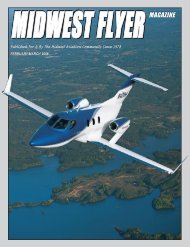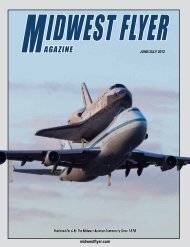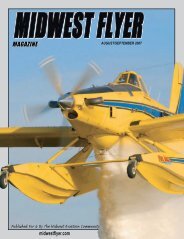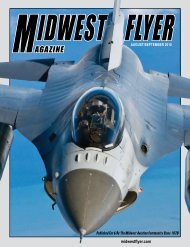Create successful ePaper yourself
Turn your PDF publications into a flip-book with our unique Google optimized e-Paper software.
incarcerated “Fido,” after he chewedon my ankle, had a checklist. Even thatstronghold of resistance to change, therailroad industry, now uses checklistsfor many functions.One thing I noted about thechecklist users mentioned here is thatthey did the function and then used thechecklist. One thing that I note aboutmany of my airplane friends is that thechecklist is used as a “Do List.” What isa “Do List.?” A “Do List” is where youmove the switch or perform the functionwhen you read it on the checklist. Not abad idea, but not the best idea.In my years operating air carrieraircraft, my employer had us follow apractice where the pilot (or copilot orflight engineer) would from memorygo through a path around the cockpit,or over a particular panel, and positionthe switches, levers, knobs, etc. in thedesired position. Then, when all ofthat was completed, the actions wouldbe again gone over in response to achecklist read by another crewmember.The checklist reader would read thename of the item of interest, and thepilot would respond with the properposition for that item.The beauty of such a system is thatitems get positioned to the desiredposition and then they are verified thatthey are really where they should be.The checklist is really a checklist; it wasby Dan McDowellImagine the beauty to be seen asthe fall colors stretch for milesbefore you. The beauty of flightenhanced by the beauty of the seasonprovides the opportunity for therenewal of the passion for aviationand flight. Thus with fall rapidlyapproaching, this is a perfect time tothink about and review the basics offlying cross-country.The Dictionary of AeronauticalTerms defines “cross-country” as,"flying from one airport to another overa distance that is long enough to requirethe use of some form of navigation."used to check that something was doneand the item is in the right position.Now you are saying, hold on, Idon't have all these crewmembers toread to me. You can read to yourself(or have your passenger do the reading.They would love the opportunity tobecome involved.) But, the readingshould be after you have gone through“The Flow.”Where do you find “The Flow?”It's on the checklist. Hopefullyyour checklist follows a logical sequenceof actions. In the Civil Air PatrolCessna 172 checklist, the preflight ofthe cockpit follows a reasonably logical,left to right sequence, across the lowerinstrument panel.Even though an item may notbe until a later checklist, you cancheck it now and then respond to thechecklist when that item is called for.For example, after you are in the seatof your aircraft, and all strapped in,before you grasp the checklist, you canstart at the lower left of the instrumentpanel and work your way to the right.Primer LOCKED, Master Switch OFF,Ignition Switch OFF, Avionics SwitchOFF, Circuit Breakers IN, lightingswitches OFF, Flashing Beacon ON,Carburetor Heat COLD, AlternateStatic Source NORMAL, ThrottleSome Cross-Country BasicsThough that may be a bit broad inscope, it does bring clearly to mind thatcross-country flying requires intelligentforethought and planning. This isbeyond what would be done for thesimple point A to point B flight for theproverbial $100.00 hamburger!As with any flight, a conscientiouspilot will begin by thoroughly planningthe intended trip. This planning shouldinclude detailed weather information,accurate course plotting and checkpointselection, headings, distances, fuelrequirements and more.It is also extremely importantto know the fuel capacity andconsumption rate for the aircraft youCRACKED 1/8 INCH, MixtureRICH, etc, etc. You can then reversecourse, go up a level, and go throughthe instruments and make sure they arelooking functional. When all of that hasbeen done, then you are ready to checkyour work. It is time for the checklist.You might be hearing that voicein the back of your mind saying, I’mnot so sure about this flow thing. Trythis. Make a little time before yournext flight. Go through the checklistand identify each item and its properposition. Maybe go through thechecklist a couple of times and noticethe path that is followed. You don'tlike the path? Make your own checklistthat follows what you think is a logicalpath. Get so you can do it withoutreference to the checklist. Once you havecompleted the flow, you are ready for thechecklist. You can read it or you can askyour companion to read it. You are onyour way to a safe and satisfying flight.Using the checklist as a Do List isbetter than nothing. Checking switchesand items in a logical and completemanner is good, and then using achecklist to check or verify your work,maximizes safety.Fly safely today and every day.EDITOR’S NOTE: Thanks onceagain to Lt. Col. Nick Modders for hiscontribution to our technical bulletin inthe interest of aviation safety, for all. qintend to fly. This information can belocated in the Aircraft Flight Manual aswell as the Pilot's Operating Handbook.Remember that FAR 91.151 requiresthat pilots have at least 30 minutes offuel remaining to be able to fly past thefirst point of intended landing duringVFR daylight operations. VFR nightoperations require 45 minutes of fuelremaining.Another important part of safe andefficient cross-country flying that isoften overlooked is the practice of goodcockpit management. Most experiencedand professional pilots keep theircockpits neat and organized from thestart of their flight until their mission iscompleted for the day.Continued On Page 55OCTOBER/NOVEMBER 2012 MIDWEST FLYER MAGAZINE 53
















